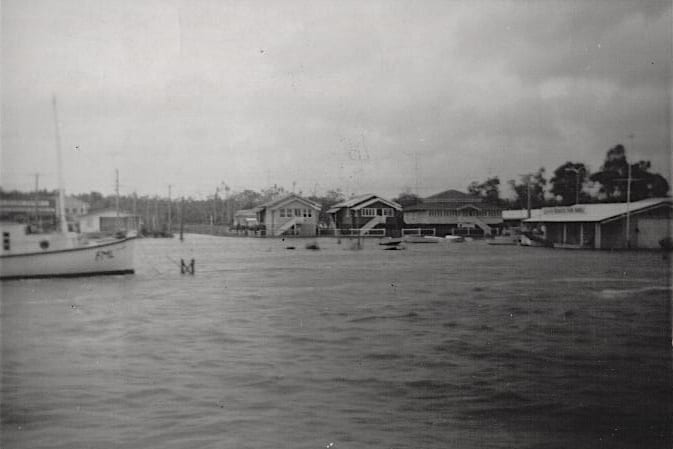Gympie Terrace is built on the riverbank of a tidal estuary on a section of the Queensland coast that has high precipitation and is frequently affected by the edges of tropical cyclones. It is only natural that there are regular floods. Usually these are relatively minor and even when they are more severe, other parts of the coast receive the brunt of such storms. But floods have been part of life ever since homes were built on Gympie Terrace.
A flood associated with a tropical cyclone that curved over K’gari (Fraser Island) in 1890 was reported as the worst flood in Noosa since 1870.
One of the worst floods recorded in southeast Queensland (and particularly destructive in Brisbane) occurred at the start of March in 1893. After nine days of heavy rain, Lake Cootharaba rose by two metres. Some homes on the Noosa River were washed away. The remains of the Cootharaba sawmill were destroyed. The houses along Gympie Terrace were isolated by water. The water was found to be knee-deep under Frederick Goodchap’s house by a relief party. The Goodchaps were given board at the Royal Mail Hotel in Tewantin, despite being fully occupied with visitors already. There was a concern about a shortage of flour.

Brisbane floods, 1893. Image courtesy of John Oxley Library
Heavy rain ruined Christmas for many in 1933, with campers at Gympie Terrace and Munna Point having to abandon their tents and seek refuge on shop verandahs or wherever they could. Even returning to Brisbane was difficult due to bogged roads and submerged bridges. The rains continued into 1934 with land washing away from Munna Point in January.
In 1936 a storm came in from the ocean that forced the residents to move their boats off the beach along Gympie Terrace and anchor them in the middle of the river.

1948 floods, Gympie Terrace. Image courtesy of Sunshine Coast Libraries

Newcastle Sun, 25th March 1948
Gympie Terrace was once again underwater in March 1948. The residents apparently did their shopping via rowboats. It flooded again in 1951.

1951 floods, Gympie Terrace

Image courtesy of Sunshine Coast Libraries
Cyclone Dinah flooded southeast Queensland in January 1967, including Noosa. Another flood the following year in January 1968 was far worse. Apparently, the residents made the most of it, catching mullet in the streets.

A submerged Doonella Bridge in the 1931 flood, with Noosaville behind it
Cyclone Wanda hit in 1974, causing quite a bit of damage to the new development, Noosa Sound. Cyclone David in 1976 was even more destructive, flooding many premises.

1992 floods, corner of Gympie Terrace & Thomas Street.
The flood of 1992 was possibly the highest since that of 1893. Parts of the Sunshine Coast received up to 700 millimetres of rain in 24 hours. There were more floods in 2007 and Cyclone Debbie also caused flooding and destruction in 2017. But like most of the floods to hit Noosa, other parts of Queensland were affected worse.
